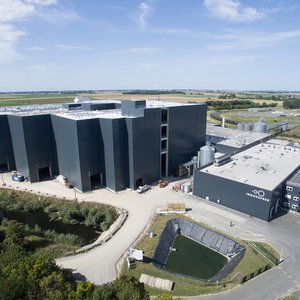Scientists at Aberystwyth University’s Institute of Biological, Environmental and Rural Sciences (IBERS) have proved that growing lupins provides a viable alternative source of soy-grade protein for animal and fish feeds in the UK.
This is the conclusion of the three year LUKAA research project Lupins in UK Agriculture and Aquaculture funded by 10 industry partners and co-funded by Innovate UK and the BBSRC. Following newly published results from the project, farmers will be advised that home-grown lupins have the potential to provide soy-grade protein.
The potential for home-grown lupins to replace imported soy in livestock, poultry and aquaculture concentrate feeds has been made clear through the three year project which has revealed that livestock, poultry and fish given rations containing lupins perform equally well and in some cases better than those fed rations of comparable quality containing soy.
Professor Nigel Scollan, Waitrose Chair of Sustainable Agriculture at IBERS and the Principal Investigator on this research project said: “The UK and Europe have major issues with protein security within the livestock and fish sectors and are heavily dependent on imported soya. Our research findings here have proven that we can increase the amount of protein that can be grown here in the UK, with proven practical and economic benefits to producers.”
The aim of the project was to look at sweet (edible) lupins which are high in protein, as a viable UK-grown alternative protein source to go into animal and fish feeds to replace as far as possible, and ideally up to 100%, the soya protein component.
Professor Nigel Scollan added: “The three main varieties - white, yellow and narrow-leafed - offered crude protein levels of 28-42% and a more favourable amino acid profile than either beans or peas.
“There is clear evidence that lupins could help as a replacement for soy with no compromise to performance.”
This has far-reaching implications for the food and farming industry, where imported soy has long been a key source of protein in animal feeds.
However, there have been barriers to the uptake of crops such as lupins, including the lack of an infrastructure between farms and the feed-milling industry, the limited range of approved herbicides and possibly even a lack of confidence amongst farmers that lupins can match the animal performance of soy.
But many of these concerns have been laid to rest by these findings whose publication coincides with some broader political and economic factors which could help drive the lupin-growing industry forward.
These include the increasing unacceptability and cost of importing soya, the declining availability of non-genetically modified (GM) soya and a widespread desire to improve UK food security in the face of volatile international markets.
A further significant impetus to the uptake of lupins is expected to come from the Common Agricultural Policy whose new ‘greening’ rules will be compulsory for those in receipt of the ‘Basic Payment’ which comes into effect this year.
Although the impact of these rules will vary from farm to farm, there will be a general trend towards more crop diversification which will encourage the growth of crops such as lupins, particularly by arable farmers.
Lupins in aquaculture
The performance of lupins in aquaculture - an industry which has rapidly grown in scale to eclipse that of beef production - was perhaps the most promising of all.
Professor Simon Davies from Plymouth University said his trials revealed better feed conversion efficiency, growth rates and mineral utilization in some species of fish, and he said that adding enzymes to the feed (SynergenTM from Alltech) improved its utilization.
“Lupins are a very effective substitute for soyabean meal but adding a cocktail of enzymes had an even more beneficial effect,” he said.
Overcoming the barriers
However, despite the performance potential of lupins, barriers to their uptake by the UK’s farmers have to be overcome.
John Cussans from NIAB TAG said options for weed control needed further exploration and full approval for use in lupins was needed for a wider range of herbicides.
However, he said the trials had identified herbicides which were suitable for use in lupins and that these - together with inter-row spraying - meant that weed control was less of a barrier than in the past.
David McNaughton from Soya UK said it was a ‘minor tragedy’ that arable farmers were not growing such aggressive nitrogen fixers as a cash crop and added: “We can now advise farmers more accurately than before on the correct variety of lupin for their area.
“Lupins are a far more attractive option today for the arable farmer than only a year ago,” he added.
Furthermore, he said: “Most dairy production in Australia is based on lupin protein but this project has confirmed the cloud that’s dogged us for years over whether lupins really are that good - and the answer is ‘yes they are’.”
However, he regretted: “Because the market demand is not there we find ourselves in a classic chicken and egg situation because the feed sector has not said they will buy thousands of tonnes.”
However, Emyr Jones from Wynnstay suggested the feed manufacturer would be likely to allocate a raw material bin to lupins if an annual commitment from growers could be given of at least 2,000 tonnes.
“Every time we look at a product we have to know we will have it for the duration,” he said, adding that Wynnstay could be expected to start using lupins in poultry feed and move on to other livestock species.
However, he said the move had to be driven by retailers who should encourage the use of home-grown proteins.
“We have to talk to the retailers and tell them that we have the answer to protein security but it has to be a team effort,” he said.
Tony Burgess said he would be making the switch for his poultry as soon as practicably possible, and added: “Within three years, I would like to see the UK countryside being awash with lupins.”










